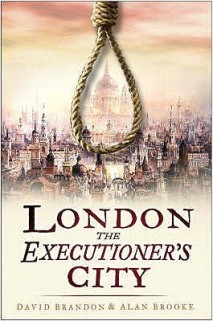
London: The Executioner’s City, by David Brandon and Alan Brooke (2006) starts by tracing the development of capital punishment in London as an instrument of penal policy as far back as records permit. They situate the act of execution within the social, political and religious context of a given period, though of course the sources become increasingly plentiful, particularly for the eighteenth century onwards.
They then look at the major execution sites, and some of the notable individuals who have suffered the severest penalty. These sites moved around the capital as it expanded and the focus is on different places at various times – the Tower, Smithfield, Newgate, Tyburn, Wapping, and various minor locations north and south of the river – though capital punishment was administered at a large number of spots, many now lost to history.
The book finishes by describing some of the notable executioners, and the crowds attending the spectacles. The changing nature of the crimes for which execution was deemed appropriate is covered (the number including some astonishingly trivial offences), as is attitudes to execution. Its role as the deterrent it was intended to be was increasingly marginalised as it took on the form of lively theatrical entertainment, chaotic scenes often threatening disorder.
That ambiguity drove capital punishment out of the public sphere and into the privacy of the prison in 1868. The volume of executions had already decreased as incarceration and transportation superseded it for a wide range of transgressions. Freed of the associations with entertainment it became a more sober affair, and public opinion, aided by miscarriages of justice, gradually swung against it in the following century until its abolition in the 1960s.
While the topic is inevitably morbid, Brandon and Brooke’s treatment is non-sensational. Details of the crimes for which malefactors were punished make it a fascinating look at a significant, if distasteful, element of English cultural history, the reasons for execution and the forms it took evolving over several hundred years. Those who want to bring capital punishment back should note that on this evidence its effect as a suppressor of violent criminality is strictly limited, and advocacy says much about the character of the proponent.
